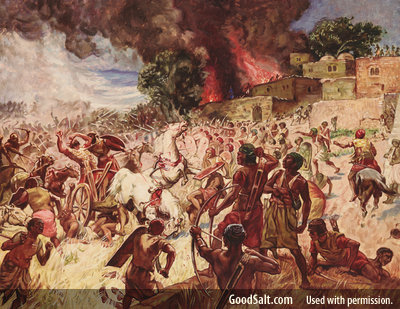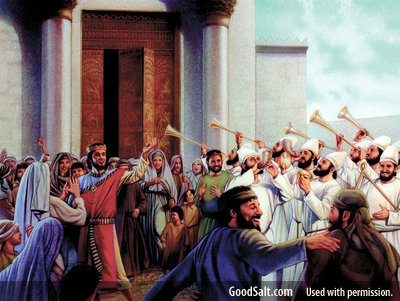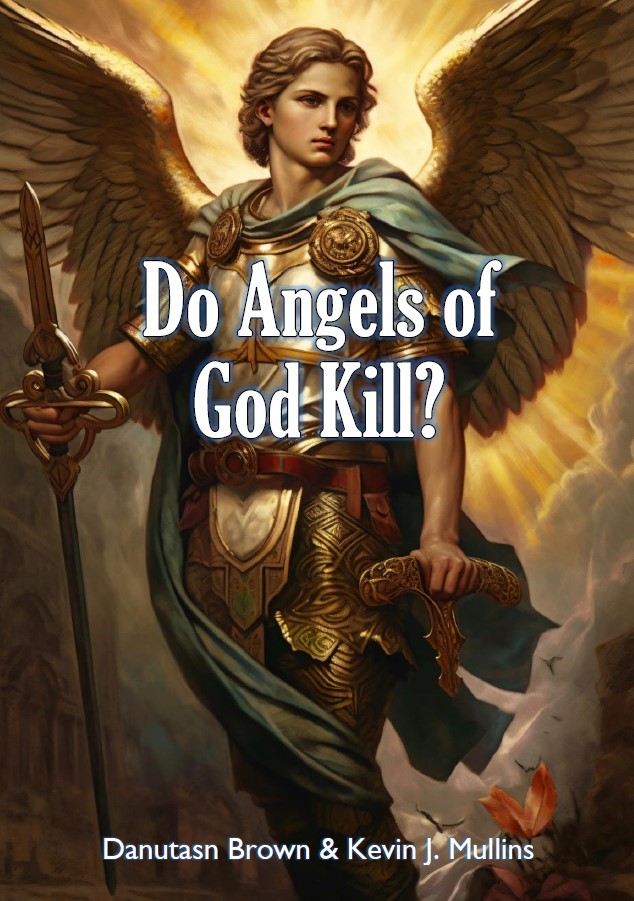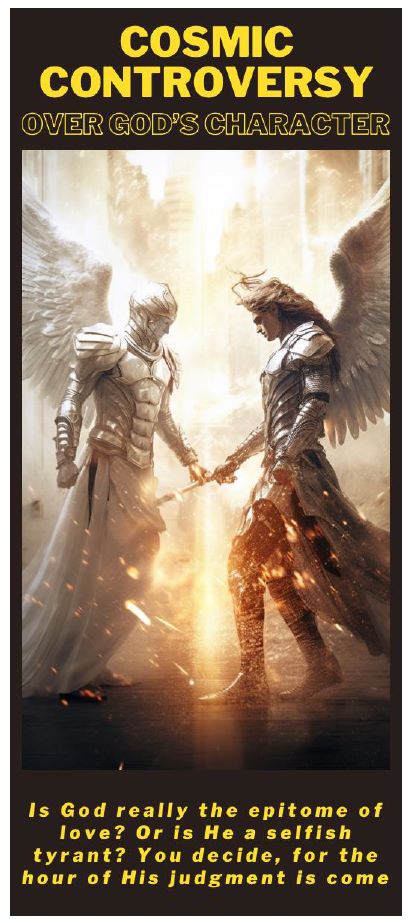(Revelation 16) What is the Battle of Armageddon?
In this study we are going to jump right to the sixth of seven last plagues found in Revelation chapter 16 regarding the battle of Armageddon. As we do this, we will be building a good solid foundation as to how to understand the remaining plagues correctly. In our next study we will discuss the other remaining plagues.
“And the sixth angel poured out his vial upon the great river Euphrates; and the water thereof was dried up, that the way of the kings of the east might be prepared. And I saw three unclean spirits like frogs come out of the mouth of the dragon, and out of the mouth of the beast, and out of the mouth of the false prophet. For they are the spirits of devils, working miracles, which go forth unto the kings of the earth and of the whole world, to gather them to the battle of that great day of God Almighty. Behold, I come as a thief. Blessed is he that watcheth, and keepeth his garments, lest he walk naked, and they see his shame. And he gathered them together into a place called in the Hebrew tongue Armageddon.” (Revelation 16:12-16)
In Revelation chapter 16 we see that the final battle between God and Satan is commonly called “Armageddon.” Many people speculate that this is referring to Zechariah 12:11 which says, “In that day shall there be a great mourning in Jerusalem, as the mourning of Hadadrimmon in the valley of Megiddon” (KJV). Here it is again in the English Standard Version: “On that day the mourning in Jerusalem will be as great as the mourning for Hadad-rimmon in the plain of Megiddo.” The popular belief is that all the world’s military will be gathered at Megiddo. Below are a couple of theories:
1. "The word 'Armageddon' comes from a Hebrew word Har-Magedone, which means 'Mount Megiddo' and has become synonymous with the future battle in which God will intervene and destroy the armies of the Antichrist as predicted in biblical prophecy (Revelation 16:16; 20:1-3). There will be a multitude of people engaged in the battle of Armageddon, as all the nations gather together to fight against Christ. The exact location of the valley of Armageddon is unclear because there is no mountain called Meggido. However, since 'Har' can also mean hill, the most likely location is the hill country surrounding the plain of Meggido, some sixty miles north of Jerusalem. More than two hundred battles have been fought in that region. The plain of Megiddo and the nearby plain of Esdraelon will be the focal point for the battle of Armageddon, which will rage the entire length of Israel as far south as the Edomite city of Bozrah (Isaiah 63:1) … The word 'Armageddon' only occurs in Revelation 16:16, 'Then they gathered the kings together to the place that in Hebrew is called Armageddon.' This speaks of the kings who are loyal to the Antichrist gathering together for a final assault on Israel. At Armageddon 'the cup filled with the wine of the fury of [God’s] wrath' (Revelation 16:19) will be delivered, and the Antichrist and his followers will be overthrown and defeated.” (gotquestions.com)
2. "Although we don’t have an exact location for Armageddon, we can surmise from its name ('mount' or 'hill') that the battle will take place on a hilly spot. Some have placed the battle about 60 miles north of Jerusalem where:
- Barak fought the Canaanites, a people known for living in depravity (Judges 4:15)
- Saul and his sons perished in battle (1 Samuel 31:8) against the Philistines, one of Israel’s most known and infamous enemies
- Pharaoh Necho of Egypt, of whom Israel has had a tumultuous history, killed Josiah, one of the few good kings of Judah who turned the nation back to God (2 Chronicles 35:22)
It would make sense to place the battle out there due to Israel’s history of that location. It symbolizes a holy people coming against enemies of darkness. We also know that God ultimately wins this battle, even if the enemy pulls armies from all the ends of the earth to cross the Euphrates to destroy God’s people.” (Christianity.com)
As we look at the meaning behind Armageddon, we must first remember that the book of Revelation is a book full of literal and symbolic imagery. Literal events in history reflect what is taking place in spiritual events. As we look at this battle correctly, allowing Scripture to define itself, we will come to a totally different understanding from the two commonly held descriptions sited above.
The Greek word John uses here in Revelation is ‘Aρμαγεδών which is transliterated as Harmagedon. The “h” sound at the beginning of this word comes from that apostrophe before the Greek letter ‘A. This is known as a rough breathing mark in Greek, since the Greek language had no letter “h” and so they instead used this mark to convey that “h” sound. Now, the word “har” at the beginning of Harmagedon means “mountain” and so the term cannot be referring to the “valley” or “plain” of Megiddon (Megiddo) found in the book of Zechariah. As correctly stated in the quotations above, there is no mountain in the valley of Megiddo or in the entire region for that matter. Contrary to the quotations above, there is no significant “hill” either. It is completely flat except for an artificial mound created by multiple layers of man-made labor around the area. Today it is called the Jezreel Valley, which, as you can see from the picture below, is bordered by highlands.
“The Jezreel Valley, also known as the Valley of Megiddo, is a large fertile PLAIN and inland valley in the Northern District of Israel. It is bordered to the north by the highlands of the Lower Galilee region, to the south by the Samarian highlands, to the west and northwest by the Mount Carmel range, and to the east by the Jordan Valley, with Mount Gilboa marking its southern extent. The largest settlement in the valley is the city of Afula, which lies near its center.” (Wikipedia)
Another reason we can be sure that John is not referring to the city of Megiddo is found in the context surrounding Zechariah 12:11:
“In that day shall the LORD defend the inhabitants of Jerusalem; and he that is feeble among them at that day shall be as David; and the house of David shall be as God, as the angel of the LORD before them. And it shall come to pass in that day, that I will seek to destroy all the nations that come against Jerusalem. And I will pour upon the house of David, and upon the inhabitants of Jerusalem, the spirit of grace and of supplications: and they shall look upon Me whom they have pierced, and they shall mourn for him, as one mourneth for his only son, and shall be in bitterness for him, as one that is in bitterness for his firstborn. In that day shall there be a great mourning in Jerusalem, as the mourning of Hadadrimmon in the valley of Megiddon.” (Zechariah 12:8-11)
Clearly God is speaking of the city of Jerusalem as being the place of this great battle and the result will be “as (or just like) the mourning of Hadadrimmon in the valley of Megiddon.” God is simply using “the valley of Megiddon” as a comparison. So, this great battle at “Mount Magedon” is in connection with “Jerusalem” and not the area of Megiddo(n).
What is the Meaning of “Magedon”?
We must first remember that John is attempting to transliterate this Hebrew word into Greek. To transliterate a word is different from translating a word. To translate a Hebrew word into Greek is to present a Greek word that means the same as the Hebrew word. To transliterate a Hebrew word into Greek is to give us the pronunciation of the Hebrew word. John is attempting to pronounce the Hebrew word in Greek by using Greek letters that give the same or approximate sounds as the Hebrew letters.
For example, if we were to transliterate the name of our Messiah from Hebrew to English, we would type out the letters “Y-E-S-H-U-A” or the long form as “Y-E-H-O-S-H-U-A.” This is where the modern English name “Joshua” comes from. The English word “Jesus” comes from the Greek and Latin, not Hebrew. In Greek there is no “sh”, so the closest they can come is just simply using an “s” called a sigma. There are two forms for the letter Sigma. When written at the end of a word, it is written like this: ς. If it occurs anywhere else, it is written like this: σ. In Greek the name Yeshua is Ἰησοῦς and is transliterated into English as Iēsoús. In Latin the name is transliterated as Iesus and from there we get Jesus in English.
In the King James Version of Hebrews 4:8 it says, “For if Jesus had given them rest, then would He (God) not afterward have spoken of another day.” Even though this is a correct modern transliteration from the Greek (more so Latin) into English, it is not speaking about Jesus the Messiah, but to Joshua (or Yehoshua in Hebrew) whom we read about in the Old Testament. Jesus and Joshua have the same Hebrew name – Yeshua/Yehoshua. Other examples of transliterations would be:
- Jerusalem (Yerushalayim)
- Isaiah (Yeshayahu)
- Jeremiah (Yirmeyahu)
- Ezekiel (Yechezekel)
- Judah (Yehudah)
- Israel (Yisrael)
Concerning the word Magedon (or, Megiddo), there are two letters that can be used in transliterating the Hebrew letter “g” into Greek and English translations. Keeping in mind that, as with many early Semitic alphabets, most of the Hebrew literature is written without vowels, here are the Hebrew letters behind “Megiddo”:
מ (mem) ג (gimel) ד (daleth) – M – G – D
The same “m-g-d” can be represented another way, with a different Hebrew letter in the middle:
מ (mem) ע (ayin) ד (daleth)
The sound of the letter ayin is made in the back of the throat and sounds similar to hard “g” (or, “gh”) while gargling, or the sound you would make to bring up phlegm in order to spit. Neither Greek nor English has a letter that approximates the sound of ayin other than hard “g.” Therefore, it is represented as a backwards apostrophe (a.k.a backquote) when being transliterated into English. M – ‘ – D
A great example of a Hebrew word that begins with the letter ayin in Hebrew but is represented by “g” in English transliterations is עֲמֹרָה (‘amorah), which is pronounced “Gomorrah.” This same transliteration style can also be applied to the word John is trying to describe which is often transliterated as “Armageddon.” If we replace the gimel with the ayin we get: h – r – m – ‘ – d. Not surprisingly, this word actually appears in the book of Isaiah as מוֹעֵד הַר (har mo‘ed), which is pronounced har-mo-gehd and is the very mountain Satan desires to take over:
“How art thou fallen from heaven, O Lucifer, son of the morning! how art thou cut down to the ground, which didst weaken the nations! For thou hast said in thine heart, I will ascend into heaven, I will exalt my throne above the stars of God: I will sit also upon the mount of the congregation (har mo‘ed), in the sides of the north: I will ascend above the heights of the clouds; I will be like the most High.” (Isaiah 14:12-14)
We have briefly discussed this when studying the Table of Showbread which was placed on the north side of the sanctuary, representing God’s throne. We saw that the mountain “in the sides of the north” is Mount Zion:
“Great is the LORD, and greatly to be praised in the city of our God, in the mountain of His holiness. Beautiful for situation, the joy of the whole earth, is mount Zion, on the sides of the north, the city of the great King … We have thought of thy lovingkindness, O God, in the midst of thy temple.” (Isaiah 48:1, 2, 9)
If you were to do a study on mountains or hills in the Bible you will notice that hills represented places of worship. People of ancient times believed that the gods (and even the God) dwelt in the high places of the hills. Just before God led the Israelites into the Promised Land God said, “Ye shall utterly destroy all the places, wherein the nations which ye shall possess served their gods, upon the high mountains, and upon the hills, and under every green tree.” (Deuteronomy 12:2; see also 1 Kings 20:23).
“Mount Zion: is a hill in Jerusalem, located just outside the walls of the Old City [highest point being 765 m (2,510 ft)]. The term Mount Zion has been used in the Hebrew Bible first for the City of David (2 Samuel 5:7, 1 Chronicles 11:5; 1 Kings 8:1, 2 Chronicles 5:2) and later for the Temple Mount, but its meaning has shifted and it is now used as the name of ancient Jerusalem's Western Hill. In a wider sense, the term is also used for the entire Land of Israel.” (Wikipedia, words in brackets my own)
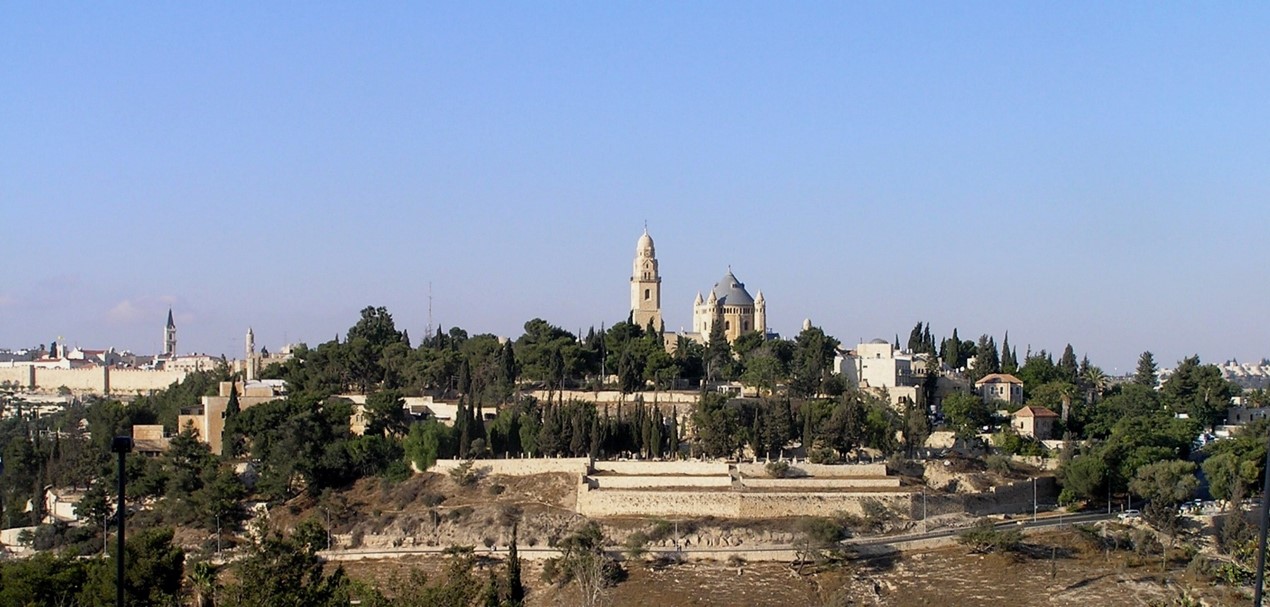
Notice the quote from Isaiah 48 above connects God’s temple with “mount Zion.” We have seen that Paul foretold that the “man of sin” (represented by the little horn/papacy) “sits in the temple of God, showing himself that he is God” (2 Thessalonians 2:3-4). We learned that Paul is not talking about a literal temple made with human hands, but saw that this represents Satan’s desire to remove God and sit on the throne of our minds and hearts within our soul temple. “Know ye not that ye are the temple of God, and that the Spirit of God dwelleth in you?” (1 Corinthians 3:16).
To counter this plan by Satan, God desires to rewrite His Law within our minds and hearts. In Isaiah chapter 51 we read:
“Hearken unto Me, My people; and give ear unto Me, O My nation: for a Law shall proceed from Me, and I will make My judgment to rest for a light of the people … Hearken unto Me, ye that know (experience) righteousness, the people in whose heart is My law; fear ye not the reproach of men, neither be ye afraid of their revilings … And I have put My words in thy mouth, and I have covered thee in the shadow of Mine hand, that I may plant the heavens, and lay the foundations of the earth, and say unto Zion, Thou art My people.” (Isaiah 51:4, 7, 16)
So, God’s Law will go forth and rest in the hearts and minds of His people, represented by Zion. In Revelation 14:1 we read:
“And I looked, and behold, the Lamb was standing upon Mount Zion, and with Him one hundred forty-four thousand having His name (character) and the name (character) of His Father having been written on their foreheads.” (Berean Literal Bible)
Satan, however, attempts to take over the “mount of the congregation” – Har Mo‘ed – in order to put a stop to the work of experiencing God’s righteousness as God’s Law is sealed in His people through the Spirit of Christ. He does not want God’s true character revealed; for when it is revealed (through God’s people) Satan’s end will come.
By simply reading the description John gives, it is quite clear that the battle of Armageddon is not a physical battle using earthly weaponry that takes place in a literal geographical location. Take a look at some of these thoughts found in The Interpreter’s Dictionary of the Bible. Words in brackets [ ] my own. Words in parenthesis ( ) in original:
“ARMAGEDDON - … A word said by the ‘Seer’ [John] to be a ‘Hebrew’ word, designating the scene of the last struggle of the forces of good and evil against each other. Unfortunately for our understanding of its meaning, the word (or phrase) does not occur anywhere in Hebrew, and some doubt even exists as to its proper spelling in the Greek … Suggested interpretations include: (a) ‘city … of Megiddo’; … (b) ‘land … of Megiddo’; (c) ‘Mount Megiddo,’ as designating that portion of Mount Carmel upon or near which the city of Megiddo lay; (d) … ‘the mount of assembly’; Isa. 14:13 … or ‘the city of desire’ – i.e. Jerusalem, or again Hebrew har migdo (‘His fruitful mountain’ – i.e., Mount Zion).
"The last suggestion [Mount Zion] seems most likely, in view particularly of the fact that in the book of Revelation 9:13-11:14; 14:14-20; 16:12-16 are all coordinate passages taking much of their imagery from Joel and that here it is from Mount Zion that the power of God in his warfare against the forces of evil is to proceed (Joel 2:32; 3:16-17, 21) … As no Mount Megiddo is known to either ancient or modern geographers, it appears the more likely that in a book abounding in symbolic language this term also should be meant to carry a symbolic meaning such as that suggested. It is to be noted, moreover, that the battle said to take place on this spot is clearly one of ideologies (the gospel [good news] versus the ‘badspell’ [bad news], God’s truth opposed to Satan’s error) – c.f., e.g., the ‘prophesying’ of the two witnesses in Revelation 11:4 ff; the fact that Satan fights by means of ‘demonic spirits’ which issue from the mouths of dragon, beast and false prophet in Revelation 16:12-16; and that in the co-ordinate passage at 19:11-16 the ‘Word of God,’ [Jesus] who leads the forces of righteousness, wields as his weapon a ‘sharp sword’ issuing from his mouth (vs. 15).”
With this definition we can see that “Armageddon” is the final battle of authority (truth vs. error) over our hearts and minds. This battle prophetically takes place at “mount Zion.” There are many who believe that God is going to call believers from all over the earth to travel to Jerusalem and fight for Israel in a literal physical war. But if mount Zion is used here as being symbolic, then we should apply the same interpretation to Jerusalem. Remember Paul’s words in the book of Hebrews:
“For you (those who are in Christ) have not come unto the mount that can be touched … But you have come unto mount Zion, and unto the city of the living God, the heavenly Jerusalem … and to the company and assembly of the firstborn, which are written in heaven … To Jesus, the Mediator of the New Covenant ...” (Hebrews 12:18, 22-24)
This is all in fulfillment of the prophet Micah who said:
“But in the last days it shall come to pass, that the mountain of the house of the LORD shall be established in the top of the mountains, and it shall be exalted above the hills; and people shall flow unto it. And many nations shall come, and say, Come, and let us go up to the mountain of the LORD, and to the house of the God of Jacob; and He will teach us of His ways, and we will walk in His paths: for the Law shall go forth of Zion, and the word of the LORD from Jerusalem … Now also many nations are gathered against thee, that say, Let her be defiled, and let our eye look upon Zion. But they know not the thoughts of the LORD, neither understand they His counsel: for He shall gather them as the sheaves into the floor.” (Micah 4:1, 2, 11, 12)
So, the prophecy of “mount Zion” in “Jerusalem” is not to be taken in the earthly sense, but is “the heavenly Jerusalem”, which is God’s people (His church) comprised of all the true believers in His Son who said …
“He who overcomes, I will make him a pillar in the temple of My God, and he shall go out no more. I will write on him the name of My God and the name of the city of My God, the New Jerusalem, which comes down out of heaven from My God. And I will write on him My new name.” (Revelation 3:12, New King James Version)
And later, John sees:
“Now I saw a new heaven and a new earth, for the first heaven and the first earth had passed away. Also there was no more sea. Then I, John, saw the holy city, New Jerusalem, coming down out of heaven from God, prepared as a bride adorned for her husband … Then one of the seven angels who had the seven bowls filled with the seven last plagues came to me and talked with me, saying, ‘Come, I will show you the bride, the Lamb’s wife.’ And he carried me away in the Spirit to a great and high mountain, and showed me the great city, the holy Jerusalem, descending out of heaven from God, having the glory (character) of God.” (Revelation 21:1, 2, 9-11, New King James Version)
Notice again that the “New Jerusalem” is not a literal city, but a heavenly city comprised of God’s people – Jesus’ bride. It is this “city” and “high mountain” that Satan desires to control.
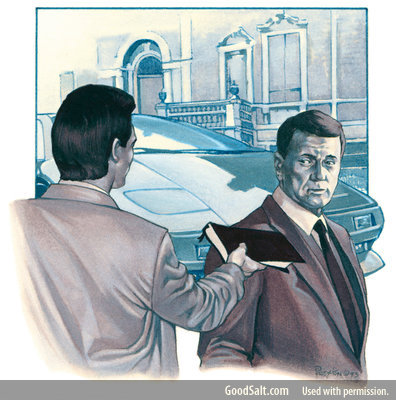 God’s people do not wield earthly weapons to destroy people (Zechariah 4:6; Matthew 26:52) but spiritual weapons to destroy satanic lies in order to help, build up, heal and restore others. Yes, sometimes the healing process consists of a tearing down since the sword we use is a “two-edged sword” (Hebrews 4:12) which cuts both ways – in and then out. This two-edged sword comes out of Christ’s “mouth” (Revelation 1:16; 19:1), it is a weapon of sharp convicting words of truth, designed to melt their hearts and bring repentance and reconciliation. Those who profess to be God’s people will use the same weaponry. Concerning the weapons we use in this warfare, Paul writes:
God’s people do not wield earthly weapons to destroy people (Zechariah 4:6; Matthew 26:52) but spiritual weapons to destroy satanic lies in order to help, build up, heal and restore others. Yes, sometimes the healing process consists of a tearing down since the sword we use is a “two-edged sword” (Hebrews 4:12) which cuts both ways – in and then out. This two-edged sword comes out of Christ’s “mouth” (Revelation 1:16; 19:1), it is a weapon of sharp convicting words of truth, designed to melt their hearts and bring repentance and reconciliation. Those who profess to be God’s people will use the same weaponry. Concerning the weapons we use in this warfare, Paul writes:
“For though we walk in the flesh, we do not war after the flesh: (For the weapons of our warfare are not carnal, but mighty through God to the pulling down of strong holds;) Casting down imaginations, and every high thing that exalteth itself against the knowledge of God, and bringing into captivity every thought to the obedience of Christ; And having in a readiness to revenge all disobedience, when your obedience is fulfilled.” (2 Corinthians 10:3-5)
A great example of this concept is I recently had to go to the Dentist for a toothache. To heal the tooth, they had to grind the tooth down and build it back up. Spiritually speaking, to heal us God needs to grind us down, or kill our “old man” of sin (our selfishness) and build us back up with new life through His indwelling Spirit (Deuteronomy 32:39; Romans 6:4-6). In the final healing process, my Dentist placed a crown upon my restored tooth. Likewise, God “hath stripped me of my glory, and taken the crown from my head” (Job 19:9), but “when the chief Shepherd (Jesus) shall appear, [I] shall receive a crown of glory that fadeth not away” (1 Peter 5:4).
Here is 2 Corinthians 10:3-5 again as paraphrased and expanded in the Remedy Bible:
“Remember that even though we live in the world, the war in which we are engaged is not like wars the world fights. We don't use worldly weapons designed to kill the body or destroy physical structures, nor do we use the world’s weapons of lies, distortion, manipulation, deceit, flattery, coercion, sanctions, or trickery. On the contrary, our weapons are from God and have divine power to free the mind, heal the heart, and demolish Satan's stronghold of fear, lies and selfishness. We demolish every idea, argument, doctrine, teaching or concept that infects the mind and distorts or obstructs the truth about God, and we reclaim the thoughts, feelings and attitudes into the truth about God as revealed by Jesus Christ. We stand ready to bring discipline to bear to help break destructive habits so that maturity and health will be fully realized.”
For more details on this, see the article entitled: Didn’t God Command the Israelites to Slaughter Men, Women, and Children With the Sword? Or the booklet, Canaan Conquest.
Satan is trying so desperately to stop the Law going forth from Zion (God’s people). He knows the Law is a transcript of God’s very own character and when that Law (God’s character) is in the hearts of believers, God’s glory (character) will enlighten the whole earth. “His ways”, “His paths”, and “His counsel” will expose the whole system of Babylon (modern-day error and confusion). As a result, the people will glorify the Father by coming out of “Babylon” (error and confusion) as they submit to His Holy (selfless) Spirit (His presence, attitude, life) and allow Him to renew their minds and give them new hearts inscribed with His Law (His Character; Ezekiel 36:26-27; Hebrews 8:10; Revelation 18:1-4).
A Deeper Look at Mo‘ed
The Hebrew word mo‘ed doesn’t just mean “congregation” or “assembly.” It is the same Hebrew word God uses to describe His Feast Days and Sabbaths when His people would congregate or assemble. Just before God outlines His Feast Days and Sabbaths He says:
“... Speak unto the children of Israel, and say unto them, Concerning the feasts (mo‘ed) of the LORD, which ye shall proclaim to be holy convocations (assemblies), even these are My feasts (mo‘ed).” (Leviticus 23:1, 2)
Strong’s Concordance defines mo‘ed as: “appointed sign, time, place of, solemn assembly, congregation, set, solemn feast … properly, an appointment, i.e. A fixed time or season; specifically, a festival …”
The word mo‘ed is also used in Genesis 1:14 which says:
“And God said, Let there be lights in the firmament of the heaven to divide the day from the night; and let them be for signs, and for seasons (mo‘ed), and for days, and years.”
Right here we see God establishing His annual Feast Days and Sabbaths on the fourth day of creation. In the Holman Christian Standard Bible, it is translated like this: “They will serve as signs for festivals and for days and years.” In the footnote it says, “Or for the appointed times.”
Referring to this, Adam Clarke writes:
“For seasons - מועדים moadim [another spelling variation of mo‘ed in the plural]; For the determination of the times on which the sacred festivals should be held. In this sense the word frequently occurs; and it was right that at the very opening of his revelation God should inform man that there were certain festivals which should be annually celebrated to his glory.” (Words in brackets my own)
In his Exposition of the Entire Bible, John Gill writes:
“The Targum of Jonathan [Aramaic translation] is, ‘and let them be for signs and the times of the feasts, and to reckon with them the number of days, and, sanctify the beginnings of the months, and the beginnings of the years, and the intercalations of months and years, the revolutions of the sun, and the new moons, and cycles.’ And so Jarchi [medieval French Rabbi, a.k.a. Rashi] interprets ‘seasons’ of the solemn festivals, that would hereafter be commanded the children of Israel; but those uses were not for a certain people, and for a certain time, but for all mankind, as long as the world should stand.” (Words in brackets my own)
In the Theological Dictionary of the Old Testament, it says:
“According to Isa. 14:13, the gods come together on a har mô'ēd, where at one time the Babylonian king sojourned. This passage became the mythical prototype for the eschatological Har Magedon (Armageddon) of Revelation 16:16. Exegetes [textual interpreters] unanimously take the sense of this expression to be ‘mount of assembly (of the gods)’ … and the OT [Old Testament] contexts suggest rather a ‘fixed time for the assembly (of the gods)’; … to regularly recurring occasions which presumably are to be celebrated concurrently as festivals on earth as well.” (G. J. Botterweck, H. Ringgren & H. J. Fabry, eds., Vol., 8, p. 171)
On page 672 of the Englishman's Hebrew and Chaldee Concordance of the Old Testament (originally published in 1874 and recently republished by Hendrickson Publishers, Inc., in 1996), George Wigram shows us that in Genesis 1:14, mo‘ed is to be pronounced as “Moh-gehd.”

Do you think it’s just a coincidence that, as God created the sun, moon and stars to be markers for His appointed Feast Days and Sabbaths, Satan, in order to divert God’s people, has set up the system of sun-worship with its Sun-day festival right in the center? We have seen throughout these studies that Satan wants to distort, profane, and make-void God’s “Mount of Appointed Times” (His Sabbaths and Feast Days) which bring us into union with our heavenly Father. He is out “to make war with the remnant of her seed (Christ’s church), which keep the Commandments of God, and have the testimony of Jesus Christ” (Revelation 12:17), and has attempted these alterations within the Christian church through the Roman papacy.
On page 58 of The Douay Catechism, Abridgment of Christian Doctrine, it states this so plainly:
“Question. How prove you that the church hath power to command feasts and holy days?
Answer. By the very act of changing the Sabbath into Sunday, which Protestants allow of; and therefore they fondly contradict themselves by keeping Sunday strictly, and breaking most other feasts commanded by the same church.
Question. How prove you that?
Answer. Because by keeping Sunday they acknowledge the church's power to ordain feasts, and to command them under sin, and by not keeping the rest by her commandments, they again deny in fact the same power.”
It should be noted here that when they say “the church” they are not specifically speaking of the Roman Catholic Church, but to the “Christian Church” as a whole, beginning with the disciples of Jesus. It is a common belief that “the Church”, beginning with the disciples, changed the Sabbath from the seventh-day of the week (commonly called Saturday) to the first day of the week (commonly called Sunday). Thus they emphasize “the church’s power to ordain [or even to abolish] feasts.” This of course is not true and there is abundant evidence that the disciples of the first century kept observing the seventh-day Sabbath, not Sunday (Acts 13:14; 42-44; 15:21; 15:13; 17:2; 18:4). Along with the weekly Sabbath, the first century disciples also kept the annual Feast Days (Acts 2:1; 12:2-3; 18:21; 20:6, 16; 1 Corinthians. 5:6-8; 16:8).
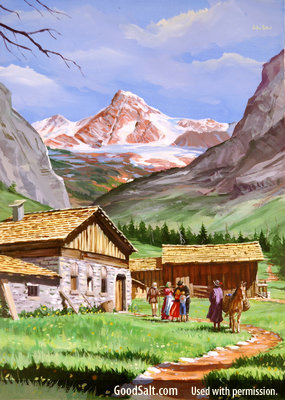
“The primitive Christians had a great veneration for the Sabbath, and spent the day in devotion and sermons. And it is not to be doubted but they derived this practice from the Apostles themselves, as appears by several scriptures to the purpose.” (Dialogues on the Lord's Day, p. 189. London: 1701, By Dr. T.H. Morer; A Church of England Divine)“The ancient Christians were very careful in the observance of Saturday, or the seventh day … It is plain that all the Oriental churches, and the greatest part of the world, observed the Sabbath as a festival … Athanasius likewise tells us that they held religious assembles on the Sabbath, not because they were infected with Judaism, but to worship Jesus, the Lord of the Sabbath, Epiphanius says the same.” (Antiquities of the Christian Church, Vol.2 Book XX, chap. 3, sec.1, 66. 1137,1138)
Please see the articles entitled: Didn’t the Disciples Observe Sunday as the New Sabbath? and What About “The Lord’s Day” and the Observance of Sunday by the Early Christian Church?
Since the disciples did not change the Sabbath nor any of the Feast Days, we can definitely conclude that it was the Roman Church who did, even though they believe (or try to say) that is was done by the disciples in the first century. In order to seal this claim, they have sought to enforce Sunday observance by law.
“Now in the matter of Sabbath observance the Protestant rule of Faith [Sola Scriptura – ‘by the Scripture alone’] is utterly unable to explain the substitution of the Christian Sunday for the [so-called] Jewish Saturday. It has been changed. The Bible still teaches that the Sabbath or Saturday should be kept holy. There is no authority in the New Testament for the substitution of Sunday for Saturday. Surely it is an important matter. It stands there in the Bible as one of the Ten Commandments of God. There is no authority in the Bible for abrogating this Commandment, or for transferring its observance to another day of the week. For Catholics it is not the slightest difficulty … The Church is above the Bible; and this transference of Sabbath observance from Saturday to Sunday is proof positive of that fact. Deny the authority of the Church and you have no adequate or reasonable explanation or justification for the substitution of Sunday for Saturday in the Third – Protestant Fourth – Commandment of God.” (Catholic Record, September 1, 1923, words in brackets my own)
We have also seen from previous studies that, not only did the Roman Church change the Sabbath, but they have also changed the Feasts because they believe that “the church” has the authority to do this.
“… The Catholic Church abolished not only the Sabbath, but all the other [so-called] Jewish Festivals.” (Bishop T. Enright, Letter, April 26, 1902, words in brackets my own)
“God simply gave His Church the power to set aside whatever day or days she would deem suitable as Holy Days. The Church chose Sunday, the first day of the week, and in the course of time added other days, as holy days.” (Vincent J. Kelly, Forbidden Sunday and Feast-Day Occupations, p. 2)
This thought-process confirms the wrong idea that God’s Law is not a Law of unchanging design, but simply an imperial code which can be changed. To attempt to change God’s Law is the equivalent of humans attempting to breathe under water without an underwater breathing apparatus. It simply can’t be done, and for anyone to step out from that design will only face inherent consequences, most likely death from drowning.
Examples of Changing the Annual Festivals
One example of this is the change of Passover to Easter. From the very beginning, the Passover has always been held on the 14th day of the first month in the Hebrew Calendar which correlates to our late March/early April, no matter which day of the week it falls upon. The Roman Church, however, desired to celebrate it according to the ancient pagan calculation of using the first Sunday after the first full moon after the vernal equinox. This controversy went well into the second and third centuries and is great evidence that the festival of Passover was still being observed by God’s people at this time. The controversy wasn’t over “if” it should be observed, but “when.”
Writing in the year 195 A.D., Polycrates tells us that he continued to observe Passover upon the same day (the 14th of the first Hebrew month) as had others before him such as Phillip, John and Polycarp "according to the gospel." Not because they were "under the Law" but "according to the rule of faith":
“Therefore, we keep the day undeviatingly, neither adding nor taking away, for in Asia [Minor] great luminaries sleep, and they will rise on the day of the coming of the Lord, when he shall come with glory from heaven and seek out all the saints. Such were Phillip… and two of his daughters… There is also John who lay on the Lord’s breast … And there is also Polycarp at Smyrna, both bishop and martyr, and Thraseas, both bishop and martyr, from Eumenaea…[Also] Sagaris,… Papirius, … and Melito … all of these kept the fourteenth day of the Passover according to the gospel, never swerving, but following according to the rule of the faith. And I also, Polycrates, the least of you all, live according to the tradition of my kinsmen, and some of them have I followed. For seven of my family were bishops and I am the eighth, and my kinsmen ever kept the day when the people put away the leaven. Therefore, brethren, I who have lived sixty-five years in the Lord and conversed with brethren from every country, and have studied all holy Scripture am not afraid of threats, for they have said, who were greater than I, ‘It is better to obey God rather than men.’” (Eusebius, Church History, Book V, Chapter 24; Nicene and Post-Nicene Fathers, Series Two, Volume 1)
So why would the Church of Rome want to change this sacred time to a time according to pagan calculations?
“The term ‘Easter’ is not of Christian origin. It is another form of Astarte, one of the titles of the Chaldean goddess, the queen of heaven. The festival of Pasch [Passover] held by Christians in post-apostolic times was a continuation of the [so-called] Jewish feast, but was not instituted by Christ, nor was it connected with Lent. From this Pasch [Passover] the pagan festival of ‘Easter’ was quite distinct and was introduced into the apostate Western religion, as part of the attempt to adapt pagan festivals to Christianity.” (Vine's Expository Dictionary of New Testament Words, words in brackets my own)
The name Easter is the modern English name for the ancient goddess of war and fertility Astarte, who is known throughout the different cultures under various names such as: Semiramis, Ishtar, Isis, Ashtoreth, Venus, Diana, Eostre and Eastre. In the book of Judges we read that “Before long, the Israelites began disobeying the LORD by worshiping Baal, Astarte, and gods from Syria, Sidon, Moab, Ammon, and Philistia” (Judges 10:6, Contemporary English Version).
“The early development of the celebration of Easter and the attendant calendar disputes were largely a result of Christianity’s [or, false Christianity’s] attempt to emancipate itself from Judaism. Sunday had already replaced the Jewish sabbath [meaning God’s Sabbath] early in the second century, and despite efforts in Asia Minor [by Polycrates and others] to maintain the Jewish Passover date of Nisan 14 … the Council of Nicaea adopted the annual Sunday following the full moon after the vernal [Spring] equinox (March 21).” (Walter Elwell, editor, Evangelical Dictionary of Theology, “Easter,” 1984, words in brackets my own)
In our study on the Little Horn (Part Two) we briefly mentioned this as we discussed the meaning behind Daniel 7:25 which states, “He (the little horn/papacy) will defy the Most High and oppress the holy people of the Most High. He will try to change their sacred festivals and laws, and they will be placed under his control for a time, times, and half a time” (New Living Translation).
Here are two other historical quotes we saw from that study:
“From Rome there came now another addition to the sun-worshiping apostasy. The first Christians being mostly Jews, continued to celebrate the Passover in remembrance of the death of Christ, the true Passover; and this was continued among those who from among the Gentiles had turned to Christ. Accordingly, the celebration was always on the true Passover day—the fourteenth of the first month. Rome, however, and from her all the west, adopted the day of the sun [Sun-day] as the day of this celebration … The rule of Rome was that the celebration [of Easter] must always be on a Sunday—the Sunday nearest to the fourteenth day of the first month of the Jewish year [Aviv/Nisan]. And if the fourteenth day of that month should fall on Sunday, then the celebration was not to be held on that day, but upon the next Sunday.” (A.T. Jones, Great Empires of Prophecy, pp. 213-214, words in brackets my own)
“The detachment of Gentile Christians from their Jewish roots was influenced by the repressive policies adopted by Roman emperors against the Jewish people and religion as well as by the defamatory campaign waged by Jews against the Christians. These factors encouraged Gentile Christians to develop a ‘Christian’ theology of contempt toward the Jews as a people and toward Judaism as a religion. A whole body of ‘Against the Jews’ literature was produced by leading Fathers who defamed the Jews as a people and emptied their religious beliefs and practices of any historical value. Two major casualties of the anti-Jews campaign were Sabbath and Passover. The Sabbath was changed to Sunday and Passover was transferred to Easter-Sunday.” (Samuele Bacchiocchi, God’s Festivals in Scripture and History, The Spring Festivals, p. 103)
We also learned in our study of the Little Horn (Part Two) that the title of “Queen of Heaven” given to Mary by the Church of Rome originates from the goddess Astarte and is mentioned in the book of Jeremiah:
“The children gather wood, and the fathers kindle the fire, and the women knead their dough, to make cakes to the queen of heaven, and to pour out drink offerings unto other gods, that they may provoke Me to anger.” (Jeremiah 7:18)
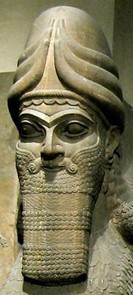 Notice that her worshipers would bake and offer small cakes to her. These cakes were inscribed with the letter “T” representing the first letter of her child’s name – “Tammuz”, who was born on December 25th. Today these cakes are called “Hot Cross Buns.” Tammuz’s father, Nimrod (see left), is the well-known founder of ancient Babylon and the chief architect of the tower of Babel (Genesis 10:9, 10). The area became known as “the land of Nimrod” (Micah 5:6). In the King James Version it says Nimrod was “a mighty hunter before the LORD” (Genesis 10:9). The word “before” is in the sense of “against,” or “in place of” because he was worshipped as a tyrannical god. It is more literally “a mighty tyrant in the face of Jehovah.” When Nimrod (also known as Baal) died, he became known as the great sun-god because it was believed he ascended into the sun.
Notice that her worshipers would bake and offer small cakes to her. These cakes were inscribed with the letter “T” representing the first letter of her child’s name – “Tammuz”, who was born on December 25th. Today these cakes are called “Hot Cross Buns.” Tammuz’s father, Nimrod (see left), is the well-known founder of ancient Babylon and the chief architect of the tower of Babel (Genesis 10:9, 10). The area became known as “the land of Nimrod” (Micah 5:6). In the King James Version it says Nimrod was “a mighty hunter before the LORD” (Genesis 10:9). The word “before” is in the sense of “against,” or “in place of” because he was worshipped as a tyrannical god. It is more literally “a mighty tyrant in the face of Jehovah.” When Nimrod (also known as Baal) died, he became known as the great sun-god because it was believed he ascended into the sun.
Every year following, in honor of their sun-god Nimrod, Astarte started a tradition throughout the kingdom of cutting down evergreen trees during the winter solstice and bringing them into their homes. They would place gifts on and around the tree as a way to give thanks for being protected, like the evergreen tree, during the winter months. This practice became the modern-day Christmas tree and is mentioned in the book of Jeremiah:
“Thus saith the LORD, Learn not the way of the heathen, and be not dismayed at the signs of heaven; for the heathen are dismayed at them. For the customs of the people are vain: for one cutteth a tree out of the forest, the work of the hands of the workman, with the axe. They deck it with silver and with gold; they fasten it with nails and with hammers, that it move not.” (Jeremiah 10:2-4)
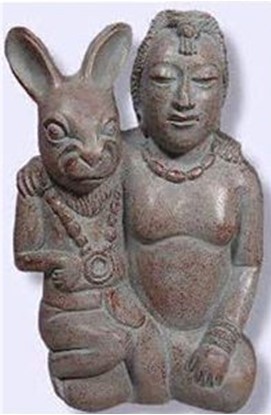 Legend states that when Astarte (also known as Semiramis, see right) died, her husband (the sun-god, Nimrod) sent her back to earth in a gigantic egg. This egg landed in the Euphrates River and settled onto the river’s floor. Then a large school of fish came and rolled the egg onto the shore while a group of doves flew down onto the egg and the warmth from their bodies hatched it. When Astarte/Semiramis came out she was then worshipped as the “moon-goddess.” Some legends state that Astarte once turned a bird into an egg-laying rabbit.
Legend states that when Astarte (also known as Semiramis, see right) died, her husband (the sun-god, Nimrod) sent her back to earth in a gigantic egg. This egg landed in the Euphrates River and settled onto the river’s floor. Then a large school of fish came and rolled the egg onto the shore while a group of doves flew down onto the egg and the warmth from their bodies hatched it. When Astarte/Semiramis came out she was then worshipped as the “moon-goddess.” Some legends state that Astarte once turned a bird into an egg-laying rabbit.
“The ancient peoples of Egypt, Persia, Greece, Rome, and China exchanged eggs at their spring fertility festivals. In Babylonia, eggs were presented to the goddess of fertility, Astarte (Eostre).” (Donna and Mal Broadhurst, Passover, Before Messiah and After, p. 157)
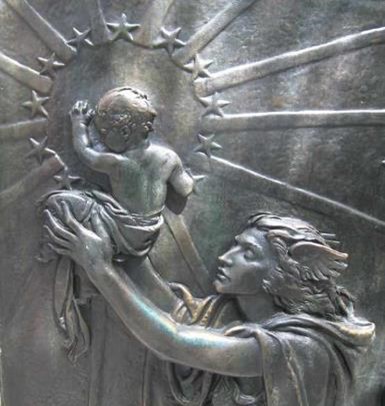 Tammuz (see left) died from a vicious attack of a wild boar on his 40th birthday and was believed to ascend into the sun as well. Every year in honor of Tammuz’s 40th birthday, the forty days preceding Astarte’s festival were set aside for fasting and self-affliction in honor of Tammuz’ death. In Humbolt’s Mexican Researches, Vol. 1, page 404 we read of pagan Mexicans who observed this forty-day period. He writes: “Three days after the vernal equinox began a solemn fast of forty days in honor of the sun.” It is this practice (now known as Lent) which is called an abomination in Ezekiel 8:13, 14:
Tammuz (see left) died from a vicious attack of a wild boar on his 40th birthday and was believed to ascend into the sun as well. Every year in honor of Tammuz’s 40th birthday, the forty days preceding Astarte’s festival were set aside for fasting and self-affliction in honor of Tammuz’ death. In Humbolt’s Mexican Researches, Vol. 1, page 404 we read of pagan Mexicans who observed this forty-day period. He writes: “Three days after the vernal equinox began a solemn fast of forty days in honor of the sun.” It is this practice (now known as Lent) which is called an abomination in Ezekiel 8:13, 14:
“He (God) said also unto me (Ezekiel), Turn thee yet again, and thou shalt see greater abominations that they do. Then He brought me to the door of the gate of the LORD'S house which was toward the north; and, behold, there sat women weeping for Tammuz.”
During the festival of Astarte the people would, not only participate in a sun-rise service, but they would eat pork (ham) as a memorial to Tammuz’ death by the wild boar. Today this in known as the Easter ham dinner, which replaced the Passover Lamb (representing Jesus) and a direct violation of God’s health design that swine is unclean (or unfit) to eat (Deuteronomy 14:7, 8; Isaiah 66:17). To the Gentile church in Corinth Paul said:
“Your glorying is not good. Know ye not that a little leaven leaveneth the whole lump? Purge out therefore the old leaven, that ye may be a new lump, as ye are unleavened. For even Christ our Passover is sacrificed for us: Therefore let us keep the feast, not with old leaven, neither with the leaven of malice and wickedness; but with the unleavened bread of sincerity and truth.” (1 Corinthians 5:6-8)
Keep in mind that this is a Gentile congregation Paul is instructing about the proper way to observe Passover and the days of Unleavened Bread now that Christ, the true Passover Lamb, has been slain. He also instructed them concerning the Feast of Firstfruits (1 Corinthians 15:20-23). We also know that Paul observed the days of Unleavened Bread with another Gentile congregation in Philippi (Acts 20:6). There would be no need for these instructions if the Gentiles were not to be observing these Feasts.
The seventh-day Sabbath, being the first Feast observed by God Himself upon this earth, is the source of all blessing and rest while the other remaining annual Festivals and Sabbaths are the channel of a magnified blessing and rest. Each build upon the other as a “body” (channel) with Jesus being the “head” (divine source) — “The Lord of the Sabbath” (Mark 2:28).
“All of these Feasts carry the signature of the Sabbath. At these times come the sweet Spirit of Christ with His sanctifying influence … If the seventh day Sabbath is a moral blessing and the Feasts take the name of the Sabbath upon them, then do they not inherit this blessing also? As Christ inherits the full blessing of His Father, then do not the Feats inherit the full blessing of the Sabbath? As the Son of God is the brightness of the Father’s glory, than are not the Feasts the brightness of the Sabbath’s glory?” (Adrian Ebens, The Ceremonial Dividing Line, p. 20)
Satan hates God’s Festivals, not only because God’s people receive double portion blessings of His Spirit (Presence) upon the appointed times, but because they are shadow pictures of prophetic events to come.
- Passover: Not only did the Festival of Passover represent the exodus from Egypt and Jesus’ death, but Jesus said it also looks forward into the future to His second coming:
“And He (Jesus) said unto them, With desire I have desired to eat this Passover with you before I suffer: For I say unto you, I will not any more eat thereof, until it be fulfilled in the kingdom of God.” (Luke 22:15, 16)
- Firstfruits: The Feast of Firstfruits not only represents the day of Jesus’ resurrection, but it also represents the resurrection of God’s people at the second coming:
“But now is Christ risen from the dead, and become the firstfruits of them that slept. For since by man came death, by man came also the resurrection of the dead. For as in Adam all die, even so in Christ shall all be made alive. But every man in his own order: Christ the firstfruits; afterward they that are Christ's at His coming.” (1 Corinthians 15:20-23)
- Pentecost: The Feast of Pentecost not only represents the day in which God spoke His Law from Mount Sinai and the day the disciples were filled with the Holy Spirit in Acts chapter 2, but also represents the time when the latter rain of Christ’s Spirit will fall in the last days:
“And it shall come to pass afterward, that I will pour out My Spirit upon all flesh; and your sons and your daughters shall prophesy, your old men shall dream dreams, your young men shall see visions: And also upon the servants and upon the handmaids in those days will I pour out My Spirit. And I will show wonders in the heavens and in the earth, blood, and fire, and pillars of smoke. The sun shall be turned into darkness, and the moon into blood, before the great and the terrible day of the LORD come [see the study entitled, What Are the Seven Seals?]. And it shall come to pass, that whosoever shall call on the name of the LORD shall be delivered: for in mount Zion and in Jerusalem (i.e. Har-mo‘ed) shall be deliverance, as the LORD hath said, and in the remnant whom the LORD shall call.” (Joel 2:28-32)
- Trumpets and Atonement: We have already seen from our studies on Daniel chapters 8 and 9 that the Feasts of Trumpets and Day of Atonement represent a time in which a rightful judgment (diagnosis) will take place and God will cleanse His people from all the lies of Satan.
- Tabernacles: The seventh and final Feast of Tabernacles not only represents the time of the Israelite’s wilderness journey from Egypt to Canaan, but looks forward to the time when all of God’s people will tabernacle together with our Creator for eternity. It represents our wilderness journey from sin to sinlessness:
“And I saw a new heaven and a new earth: for the first heaven and the first earth were passed away; and there was no more sea. And I John saw the holy city, new Jerusalem, coming down from God out of heaven, prepared as a bride adorned for her husband. And I heard a great voice out of heaven saying, Behold, the tabernacle of God is with men, and He will dwell with them, and they shall be His people, and God Himself shall be with them, and be their God.” (Revelation 21:1-3)
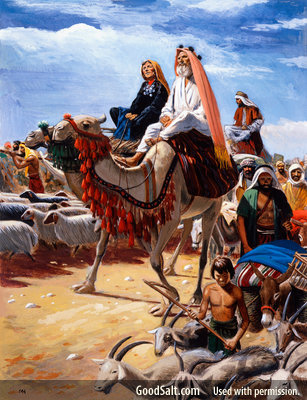 The true Promised Land was never about a small localized piece of property that was to be given to Abraham, but the dwelling place of sinlessness upon the new earth. Paul wrote: “For the promise to Abraham and his offspring that he would be heir of the world did not come through the Law but through the righteousness of faith.” (Romans 4:13, English Standard Version). The promise is for us to have the whole world; “For the meek shall inherit the earth; and shall delight themselves in the abundance of peace.” (Psalm 37:11; Matthew 5:5). And the book of Hebrews says:
The true Promised Land was never about a small localized piece of property that was to be given to Abraham, but the dwelling place of sinlessness upon the new earth. Paul wrote: “For the promise to Abraham and his offspring that he would be heir of the world did not come through the Law but through the righteousness of faith.” (Romans 4:13, English Standard Version). The promise is for us to have the whole world; “For the meek shall inherit the earth; and shall delight themselves in the abundance of peace.” (Psalm 37:11; Matthew 5:5). And the book of Hebrews says:
“By faith he (Abraham) sojourned in the land of promise, as in a strange country, dwelling in tabernacles with Isaac and Jacob, the heirs with him of the same promise: For he looked for a city which hath foundations, whose builder and maker is God … These all died in faith, not having received the promises, but having seen them afar off, and were persuaded of them, and embraced them, and confessed that they were strangers and pilgrims on the earth. For they that say such things declare plainly that they seek a country. And truly, if they had been mindful of that country from whence they came out, they might have had opportunity to have returned. But now they desire a better country, that is, an heavenly: wherefore God is not ashamed to be called their God: for He hath prepared for them a city.” (Hebrews 11:9, 10, 13-16)
And of course, upon the new earth, we will still observe His Feast Days and Sabbaths:
“For as the new heavens and the new earth, which I will make, shall remain before Me, saith the LORD, so shall your seed and your name remain. And it shall come to pass, that from one New Moon to another (monthly), and from one Sabbath to another (weekly), shall all flesh come to worship before Me, saith the LORD.” (Isaiah 66:22, 23)
In vision, both Ezekiel and John saw the new earth and the restored tree of life “which bare twelve manner of fruits, and yielded her fruit every month: and the leaves of the tree were for the healing of the nations.” (Revelation 22:1, 2; Ezekiel 47:1, 12). Yes, every month, or every New Moon Festival (Psalm 81:3; Ezekiel 46:1-3). But doesn’t Paul say the Festivals, including the New Moon and Sabbath, were done away with in Colossians 2:13-17? Please see the article entitled, Did God’s Festivals and Sabbaths Come to an End at Christ’s Death?
The Drying Up of the Euphrates River
Just before this final battle of the mind takes place John saw, “the sixth angel poured out his vial upon the great river Euphrates; and the water thereof was dried up, that the way of the kings of the east might be prepared.” (Revelation 16:12). Anciently the city of Babylon was overthrown by Cyrus who came from the east. He overthrew Babylon by diverting the Euphrates River. This literal event in history has a spiritual application in the last days. We should not expect a literal Cyrus to come from the east and dry up the Euphrates River. So what does it mean in a spiritual sense?
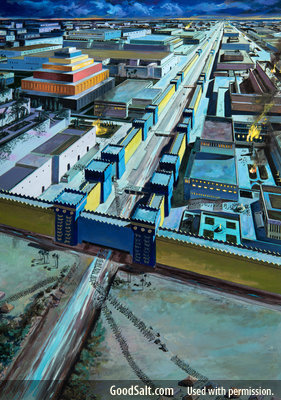 Anciently the kingdom of Babylon was built on the banks of the Euphrates River. Thus this river supported the kingdom of Babylon. Could it be a coincidence that the legend of Astarte began as her “eggship” landed in the Euphrates River? We have learned in previous studies that water in Bible prophecy represents “peoples, and multitudes, and nations, and tongues” (Revelation 17:15). It is on this water (people) where spiritual Babylon sits (Revelation 17:1, 15). Thus spiritual Babylon will be supported by people.
Anciently the kingdom of Babylon was built on the banks of the Euphrates River. Thus this river supported the kingdom of Babylon. Could it be a coincidence that the legend of Astarte began as her “eggship” landed in the Euphrates River? We have learned in previous studies that water in Bible prophecy represents “peoples, and multitudes, and nations, and tongues” (Revelation 17:15). It is on this water (people) where spiritual Babylon sits (Revelation 17:1, 15). Thus spiritual Babylon will be supported by people.
However, Scripture says that the water that supports this kingdom will be dried up. This means that people will begin to stop supporting spiritual Babylon and come out of her. As these people, who are in Babylon, hear the gospel message, represented by the three angels in Revelation 14, they will turn away from the message coming out of the mouths of the dragon, the beast, and the false prophet which is represented by the three unclean spirits like frogs, and join those who “keep the Commandments of God and have the faith of Jesus” (Revelation 14:12). Thus the supporting river will be dried up. The people (not all of them) will stop supporting this modern-day spiritual Babylon.
“And the ten horns which thou sawest upon the beast, these shall hate the whore, and shall make her desolate and naked, and shall eat her flesh, and burn her with fire. For God hath put in their hearts to fulfil His will, and to agree, and give their kingdom unto the beast, until the words of God shall be fulfilled.” (Revelation 17:16, 17)
The Kings from the East
John said that as soon as the Euphrates River was dried up, this would prepare the way for the “kings from the east” (Revelation 16:12). We learned earlier that Mount Zion is located on the “farthest sides of the north.” This mountain, represents God’s people as they assemble to receive of His Spirit upon His appointed times. God is the original King of this northern glorious mountain. Remember, this is also the mountain that Satan wishes to sit upon and control, and because most of the earth has chosen to follow Satan, he has, in a sense, sat upon the holy mountain. Although God is still the King of the northern mountain, Satan has usurped God’s position in our false doctrines and worship systems. Thus Satan has become temporary king of the northern mountain.
As said before it was Cyrus who came from the east and overthrew Babylon by diverting the Euphrates River. Again, we should not be looking for a literal Cyrus to come from the east in the last days. God said to ancient Babylon, “ ... I will dry up your rivers’; Who says of Cyrus, ‘He is My shepherd’ ... Thus says the Lord to His anointed, to Cyrus ...To open before him the double doors, so that the gates will not be shut” (Isaiah 44:27,28; 45:1, New King James Version). Did you catch what God called Cyrus? He called him a “shepherd” and “His anointed.” The word “anointed” is the same Hebrew word for messiah. “Shepherd” and “Messiah” are titles given to Jesus (John 1:41; 4:25, 26; 10:11, 14). In Isaiah 41:2 God calls Cyrus, “the righteous man from the east.” Again this literal event in history has a spiritual application in the last days.
At the very climax of the battle of Armageddon, those who remain loyal to Babylon prepare their final attack against God’s true followers, whom they believe are the ones causing all the calamities caused by the seven last plagues. At this time the kings of the east will come to their rescue. Ezekiel once wrote:
“Afterward He (God) brought me (Ezekiel) to the gate, even the gate that looketh toward the east: And, behold, the glory of the God of Israel came from the way of the east: and His voice was like a noise of many waters: and the earth shined with His glory.” (Ezekiel 43:1, 2)
It is “the God of Israel” who comes FROM the “east.” Jesus once said, “For as the lightning cometh out of (FROM) the east, and shineth even unto the west; so shall also the coming of the Son of man be.” (Matthew 24:27). And we can’t forget that the book of Revelation speaks of “another angel ascending FROM the east, having the seal of the living” (Revelation 7:2).
In Genesis 2:8 we read, “Then the LORD God planted a garden in Eden, in the East, and there He put the man He had formed” (Good News Translation). Now notice what takes place after man sins and how Scripture refers to mankind moving east in a negative connotation:
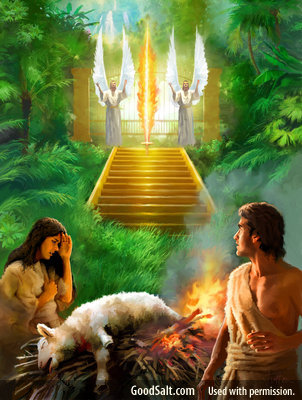 “So He (God) drove out the man; and He placed at the east of the garden of Eden Cherubim, and a flaming sword which turned every way, to keep the way of the tree of life.” (Genesis 3:24)
“So He (God) drove out the man; and He placed at the east of the garden of Eden Cherubim, and a flaming sword which turned every way, to keep the way of the tree of life.” (Genesis 3:24)
Many read this verse thinking that the angels were there to keep people out, but they was stationed there to “keep the way of the tree of life” or in other words, to make sure there was a way back to the garden.
After Cain killed his brother Abel Scripture says, “So Cain went out from the presence of the LORD and lived in the land of Nod, east of Eden.” (Genesis 4:16, Young’s Literal Translation).
In Genesis 11:2 the King James Version says, “And it came to pass, as they journeyed from the east, that they found a plain in the land of Shinar; and they dwelt there.” However, it actually means they were traveling eastward: “And as people journeyed eastward, they found a plain in the land of Shinar (ancient name for Babylon) and settled there” (Berean Study Bible and most other translations). Here is where they began to build the tower of Babel.
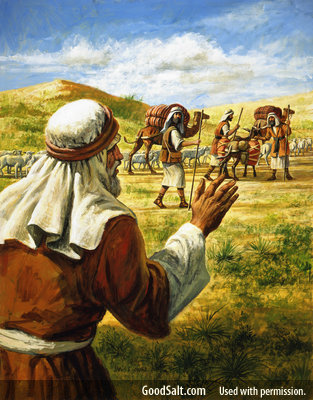 When Abraham and Lot separated from each other “Lot chose him all the plain of Jordan (the area of Sodom and Gomorrah); and Lot journeyed east: and they separated themselves the one from the other.” (Genesis 13:11).
When Abraham and Lot separated from each other “Lot chose him all the plain of Jordan (the area of Sodom and Gomorrah); and Lot journeyed east: and they separated themselves the one from the other.” (Genesis 13:11).
But if God’s glory comes “from the east,” why does Scripture suggest going “toward the east” a bad thing? Wouldn’t you be going towards God’s holiness? However, you must focus on the point of ORIGIN. Coming “FROM the east” to west represents holiness, while coming “FROM the west” represents unholiness. The reason why traveling TOWARD the east represents unholiness, as we have seen above, is because the point of ORIGIN is west. Traveling FROM the east represents holiness because the point of ORIGIN is east no matter where you are on the earth. It’s not that simply “the east” represents holiness, but the whole act of “coming from the east” which does.
So, as you can see, to GO eastward “from the west” represents that your spiritual point of origin is away from God’s understanding, or His point of view of something. Therefore, to move “FROM the east” to the west represents your spiritual point of origin as it relates to God’s understanding, or from His point of view. David says God will remove our sins (our transgression of God’s character) “from the west”:
“As far as the east is from the west, so far hath He (God) removed our transgressions from us.” (Psalm 103:12)
The door to God’s Tabernacle always faced east. When you go into the Tabernacle from the bronze Altar of Burnt Offerings and bronze Laver to the golden Menorah, Table of Showbread and Altar of Incense, and then into the Holy of Holies where God’s glory dwelt above the Mercy Seat, you are coming “from the east” to west which is a good thing because we will be looking at the sanctuary services through the understanding (point of view) of a holy God and not our fallen views. We must have our eyes spiritually looking “FROM the east” in order to understand God’s holiness as represented by the sanctuary services and its furniture. The further into the sanctuary we go (FROM the east), the more our false understanding of God is revealed, which must be done in order for us to acknowledge and confess it, permitting God to cleanse us from all unrighteousness, which results in final atonement – at-one-ment with God.
When we have eyes looking “FROM the east” (from God’s point of view) we will understand the meaning of all the animal offerings, along with why the furniture in the courtyard was made of bronze while the furniture inside the sanctuary was made of gold. We discussed the meaning of these things in the study entitled, Why Does the Sanctuary Need to be Cleansed?
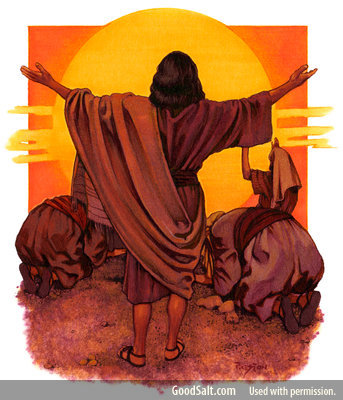 This is why God called it an abomination when He saw 25 men “with their backs toward the temple of the LORD, and their faces TOWARD the east; and they worshipped the sun TOWARD the east” (Ezekiel 8:16). Their eyes were looking TOWARD the east, meaning their spiritual point of ORIGIN and understanding was “from the west”, thus they cannot understand the true meaning of God’s holiness nor the proper meaning of the animal offerings at the sanctuary and its furniture since their spiritual point of understanding is away from His holiness. Worshipping the sun “toward the east” while at God’s temple represents their pagan understanding which they have incorporated into the sanctuary and its services, resulting in the appeasement doctrine of penal atonement which permeates Western Protestant theology. If we are looking at God’s truth through the western mindset, we will never understand His holiness.
This is why God called it an abomination when He saw 25 men “with their backs toward the temple of the LORD, and their faces TOWARD the east; and they worshipped the sun TOWARD the east” (Ezekiel 8:16). Their eyes were looking TOWARD the east, meaning their spiritual point of ORIGIN and understanding was “from the west”, thus they cannot understand the true meaning of God’s holiness nor the proper meaning of the animal offerings at the sanctuary and its furniture since their spiritual point of understanding is away from His holiness. Worshipping the sun “toward the east” while at God’s temple represents their pagan understanding which they have incorporated into the sanctuary and its services, resulting in the appeasement doctrine of penal atonement which permeates Western Protestant theology. If we are looking at God’s truth through the western mindset, we will never understand His holiness.
Now, remember, we have learned that Daniel saw the little horn power “waxed exceeding great, toward the south, and toward the east, and toward the pleasant land” (Daniel 7:8), thus its point of origin was in the west. Greece is west of Babylon and Medo-Persia, Rome is west of Greece, France is west of Rome, and the United States is west of France. When each of these kingdoms became a world-empire their point of origin was coming “FROM the west.” It is the period from Rome to the United States that Paul speaks of as the great “the falling away” (or, rebellion) caused by the “man of sin”, the “son of perdition” in 2 Thessalonians chapter 2. Daniel said this “falling away” would last for “a time, times, and a half a time” (1,260 years, Daniel 7:25) which we have learned was from 538 A.D. – 1798. It was at this time, after the “time, times, and a half” (1798) when God would end the scattering of His people and begin to gather them back into His truth (Daniel 12:7).
“The great men who built up the Western Church were almost all trained Roman lawyers … They had the lawyer’s idea that the primary duty laid upon them was to enforce obedience to authority, whether that authority expressed itself in external institutions or in the precise definitions of the correct ways of thinking about spiritual truths. No branch of western Christendom has been able to free itself from the spell cast upon it by these Roman lawyers of the early centuries of the Christian church.” (Thomas Lindsay, A History of the Reformation, p. 168)
“… the celebration [of Passover] was always on the true Passover day—the fourteenth of the first month. Rome, however, and from her all the West, adopted the day of the sun as the day of this celebration.” (A.T. Jones, Great Empires of Prophecy, pp. 213-214)
“Easter … was introduced into the apostate Western religion, as part of the attempt to adapt pagan festivals to Christianity.” (Vine's Expository Dictionary of New Testament Words)
It has been Satan’s plan to take the minds (reasoning/understanding) of God’s people from the east and brainwash them with western ideologies such as:
- Mysticism and Superstitions
- Spiritualism
- Sun-worship
- Force and Coercion
- Greek gods and Mythology
- Roman Festivals
- Intellectual Reasoning based upon Atheism and Evolution
- Charismatic Feelings and a False Sense of Security Through Signs and Miracles
- Appeasement Theology
All of these, and more, are represented by the “three unclean spirits like frogs” catching their prey with their lying tongues which “come out of the mouth of the dragon (Satan/paganism), and out of the mouth of the beast (papacy), and out of the mouth of the false prophet (United States/apostate Protestantism).”
As God’s people and truth moved “from the east” to the west through the spiritual “wilderness” during the 1,260 years (Revelation 12:6, 14), only remnants of truth survived. This is why Jesus warned the church of Philadelphia saying, “You have a little power” and then commissioned them to “Hold firmly that which you have, so that no one takes your crown.” (Revelation 3:8, 11, New Heart English Bible).
The angel coming “FROM the east” to seal us with the seal of the living God is coming from the point of origin of God’s holiness and understanding. He seals people with God’s holiness and understanding so that we and our message will begin to spiritually travel from that point of origin – “from the east.” Our gospel message will be coming “from the east” because we will be presenting truths in their original (or, proper) framework. Remember, God’s glory comes “from the east” (Ezekiel 43:2) and we have seen that God’s glory is His character (Exodus 33:18, 19), thus the message that seals us “from the east” is a message of God’s character in its original framework of truth. This sealing of God’s character in our minds and hearts will settle us into the truth, both intellectually and spiritually, so we cannot be moved.
We will come to this proper knowledge (understanding) of His character as we assemble upon His holy mountain:
 “The wolf also shall dwell with the lamb, and the leopard shall lie down with the kid; and the calf and the young lion and the fatling together; and a little child shall lead them. And the cow and the bear shall feed; their young ones shall lie down together: and the lion shall eat straw like the ox. And the sucking child shall play on the hole of the asp, and the weaned child shall put his hand on the cockatrice' den. They shall not hurt nor destroy in all MY HOLY MOUNTAIN: for the earth shall be full of the knowledge of the LORD, as the waters cover the sea.” (Isaiah 11:6-9)
“The wolf also shall dwell with the lamb, and the leopard shall lie down with the kid; and the calf and the young lion and the fatling together; and a little child shall lead them. And the cow and the bear shall feed; their young ones shall lie down together: and the lion shall eat straw like the ox. And the sucking child shall play on the hole of the asp, and the weaned child shall put his hand on the cockatrice' den. They shall not hurt nor destroy in all MY HOLY MOUNTAIN: for the earth shall be full of the knowledge of the LORD, as the waters cover the sea.” (Isaiah 11:6-9)
Again, why will we not hurt nor destroy? Because we will be full of the knowledge of the LORD. We will not hurt nor destroy because we will be filled with His character; for God never hurts nor destroys anyone (Romans 13:10). By choosing to sin, men separate themselves from God, cut themselves off from the channel of blessing, and the sure result is ruin and death. Although God Himself destroys no man, He will not interfere with man’s free choice and, out of His unselfish love, the wicked are given up to the destruction they have wrought for themselves.
To be continued ... What Are the Seven Last Plagues?

